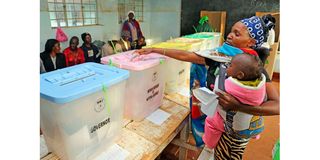Game of numbers: More women likely to win in poll

A woman casts her vote at Ratta Primary School in Kisumu County on August 8, 2017.
What you need to know:
- In 2017, IEBC cleared 1,240 women to run for various elective seats.
- In the August 9 election, 1,962 will be competing for the positions.
- Going by the mathematics of probability, at least more women will be elected next week.
Kenya goes into a third General Election, nearly 12 years since the citizens heralded a new Constitution that recognised inclusion of women in political leadership, and provided a quota for that matter.
But even with the mark of honour, it has been a long, brutal, disappointing, and bitter wait for that to become a reality.
From four failed attempts to pass the gender law to actualise Article 27(8) which requires that not more than two-thirds of the members of an elective or appointive body should be of the same gender, to suits to force the government to enact the law, which resulted in favourable rulings that were never implemented.
The latest attempt by the Independent Electoral and Boundaries Commission (IEBC) to save the situation hit a rock after the High Court suspended the directive to political parties to adhere to the two-thirds gender principle.
A lawyer, Adrian Kamotho sought a stop to the directive arguing that the electoral commission had not undertaken any public participation before issuing the notice.
Now, the ball is in the voters’ courts. Will they take it upon themselves to fulfil this provision during next week’s election?
Elected governors
In 2017, IEBC cleared 1,240 women to run for various elective seats including nine for governor, 20(senator), and 131(Woman County Representatives).
In the August 9 election, 1,962 will be competing for the seats, which means 722 more women are in the race.
Going by the mathematics of probability, at least five women would be elected governors, a rise from three in the last election. The situation may be the same for senators since three women also made it to the Senate chambers.
For Members of Parliament (MPs), at least 36 would make it to the upper house from the 23 elected in 2017.
The County Assemblies would have a minimum of 152 elected women, up from the 96 currently serving.
Two counties-Nakuru and Kirinyaga, draw special attention because Susan Kihika who was the first woman to be elected senator is vying for governor.
She is also the first Speaker of the Nakuru County Assembly and a woman in that respect.
Her candidature reignites hope of her writing history once again.
In Kirinyaga, Anne Waiguru, one of the three women elected governor in 2017, will be going to the polls to seek re-election against a fellow woman, Wangui Ngirici, whom pollsters have shown to be a strong competitor.
Counties like Nyamira and Kisii, which have never elected women MPs before and which have seen women drop out of the race citing male chauvinism, are also areas to watch. Will the men and women here settle for women candidates?




